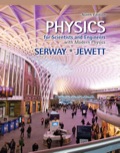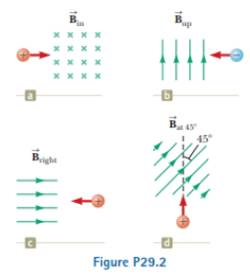
EBK PHYSICS FOR SCIENTISTS AND ENGINEER
9th Edition
ISBN: 8220100461262
Author: SERWAY
Publisher: Cengage Learning US
expand_more
expand_more
format_list_bulleted
Concept explainers
Textbook Question
Chapter 29, Problem 29.2P
Determine the initial direction of the deflection of charged particles as they enter the magnetic fields shown in Figure P29.2.

Expert Solution & Answer
Trending nowThis is a popular solution!

Students have asked these similar questions
2.2. In an experiment, a shearwater (a seabird) was taken from its
nest, flown 5150 km away, and released. The bird found its way back
to its nest 13.5 days after release. If we place the origin at the nest and
extend the +x-axis to the release point, what was the bird's average ve-
locity in m/s (a) for the return flight and (b) for the whole episode, from
leaving the nest to returning?
Use relevant diagrams where necessary and go through it in details
Your blood pressure (usually given in units of "mm of Hg") is a result of the heart muscle pushing on your blood. The left side of the heart creates a pressure of 115 mm Hg by exerting a force directly on the blood over an effective area of 14.5 cm2. What force does it exert to accomplish this? (Give your answer as the number of Newtons and note that you will need to do some unit conversions.)
Chapter 29 Solutions
EBK PHYSICS FOR SCIENTISTS AND ENGINEER
Ch. 29 - An electron moves in the plane of this paper...Ch. 29 - Prob. 29.2QQCh. 29 - A wire carries current in the plane of this paper...Ch. 29 - (i) Rank the magnitudes of the torques acting on...Ch. 29 - Prob. 29.1OQCh. 29 - Rank the magnitudes of' the forces exerted on the...Ch. 29 - A particle with electric charge is fired into a...Ch. 29 - A proton moving horizontally enters a region where...Ch. 29 - Prob. 29.5OQCh. 29 - A thin copper rod 1.00 in long has a mass of 50.0...
Ch. 29 - Prob. 29.7OQCh. 29 - Classify each of die following statements as a...Ch. 29 - An electron moves horizontally across the Earths...Ch. 29 - A charged particle is traveling through a uniform...Ch. 29 - In the velocity selector shown in Figure 29.13....Ch. 29 - Prob. 29.12OQCh. 29 - A magnetic field exerts a torque on each of the...Ch. 29 - Can a constant magnetic field set into motion an...Ch. 29 - Explain why it is not possible to determine the...Ch. 29 - Is it possible to orient a current loop in a...Ch. 29 - How can the motion of a moving charged particle be...Ch. 29 - Prob. 29.5CQCh. 29 - Charged panicles from outer space, called cosmic...Ch. 29 - Two charged particles are projected in the same...Ch. 29 - At the equator, near the surface of the Earth, the...Ch. 29 - Determine the initial direction of the deflection...Ch. 29 - Find the direction of the magnetic field acting on...Ch. 29 - Consider an electron near the Earths equator. In...Ch. 29 - Prob. 29.5PCh. 29 - A proton moving at 4.00 106 m/s through a...Ch. 29 - An electron is accelerated through 2.40 103 V...Ch. 29 - A proton moves with a velocity of v = (2i 4j + k)...Ch. 29 - A proton travels with a speed of 5.02 106 m/s in...Ch. 29 - A laboratory electromagnet produces a magnetic...Ch. 29 - A proton moves perpendicular to a uniform magnetic...Ch. 29 - Review. A charged particle of mass 1.50 g is...Ch. 29 - An electron moves in a circular path perpendicular...Ch. 29 - An accelerating voltage of 2.50103 V is applied to...Ch. 29 - A proton (charge + e, mass mp), a deuteron (charge...Ch. 29 - A particle with charge q and kinetic energy K...Ch. 29 - Review. One electron collides elastically with a...Ch. 29 - Review. One electron collides elastically with a...Ch. 29 - Review. An electron moves in a circular path...Ch. 29 - Review. A 30.0-g metal hall having net charge Q =...Ch. 29 - A cosmic-ray proton in interstellar space has an...Ch. 29 - Assume the region to the right of a certain plane...Ch. 29 - A singly charged ion of mass m is accelerated from...Ch. 29 - A cyclotron designed to accelerate protons has a...Ch. 29 - Prob. 29.25PCh. 29 - Singly charged uranium-238 ions are accelerated...Ch. 29 - A cyclotron (Fig. 28.16) designed to accelerate...Ch. 29 - A particle in the cyclotron shown in Figure 28.16a...Ch. 29 - Prob. 29.29PCh. 29 - Prob. 29.30PCh. 29 - Prob. 29.31PCh. 29 - A straight wire earning a 3.00-A current is placed...Ch. 29 - A conductor carrying a current I = 15.0 A is...Ch. 29 - A wire 2.80 m in length carries a current of 5.00...Ch. 29 - A wire carries a steady current of 2.40 A. A...Ch. 29 - Why is the following situation impossible? Imagine...Ch. 29 - Review. A rod of mass 0.720 kg and radius 6.00 cm...Ch. 29 - Review. A rod of mass m and radius R rests on two...Ch. 29 - A wire having a mass per unit length of 0.500 g/cm...Ch. 29 - Consider the system pictured in Figure P28.26. A...Ch. 29 - A horizontal power line oflength 58.0 in carries a...Ch. 29 - A strong magnet is placed under a horizontal...Ch. 29 - Assume the Earths magnetic field is 52.0 T...Ch. 29 - In Figure P28.28, the cube is 40.0 cm on each...Ch. 29 - Prob. 29.45PCh. 29 - A 50.0-turn circular coil of radius 5.00 cm can be...Ch. 29 - A magnetized sewing needle has a magnetic moment...Ch. 29 - A current of 17.0 mA is maintained in a single...Ch. 29 - An eight-turn coil encloses an elliptical area...Ch. 29 - Prob. 29.50PCh. 29 - A rectangular coil consists of N = 100 closely...Ch. 29 - A rectangular loop of wire has dimensions 0.500 m...Ch. 29 - A wire is formed into a circle having a diameter...Ch. 29 - A Hall-effect probe operates with a 120-mA...Ch. 29 - Prob. 29.55PCh. 29 - Prob. 29.56APCh. 29 - Prob. 29.57APCh. 29 - Prob. 29.58APCh. 29 - A particle with positive charge q = 3.20 10-19 C...Ch. 29 - Figure 28.11 shows a charged particle traveling in...Ch. 29 - Review. The upper portion of the circuit in Figure...Ch. 29 - Within a cylindrical region of space of radius 100...Ch. 29 - Prob. 29.63APCh. 29 - (a) A proton moving with velocity v=ii experiences...Ch. 29 - Review. A 0.200-kg metal rod carrying a current of...Ch. 29 - Prob. 29.66APCh. 29 - A proton having an initial velocity of 20.0iMm/s...Ch. 29 - Prob. 29.68APCh. 29 - A nonconducting sphere has mass 80.0 g and radius...Ch. 29 - Why is the following situation impossible? Figure...Ch. 29 - Prob. 29.71APCh. 29 - A heart surgeon monitors the flow rate of blood...Ch. 29 - A uniform magnetic Held of magnitude 0.150 T is...Ch. 29 - Review. (a) Show that a magnetic dipole in a...Ch. 29 - Prob. 29.75APCh. 29 - Prob. 29.76APCh. 29 - Consider an electron orbiting a proton and...Ch. 29 - Protons having a kinetic energy of 5.00 MeV (1 eV...Ch. 29 - Review. A wire having a linear mass density of...Ch. 29 - A proton moving in the plane of the page has a...
Knowledge Booster
Learn more about
Need a deep-dive on the concept behind this application? Look no further. Learn more about this topic, physics and related others by exploring similar questions and additional content below.Similar questions
- What is the absolute (total) pressure experienced by a diver at a depth of 17 meters below the surface of a lake? Assume that atmospheric pressure at the surface of the lake is 101,000 Pascals, g= 9.8 m/s2, and the density of the water in the lake is 997 kg/m3. Give your answer as the number of Pascals.arrow_forwardA particular solid cube has an edge of length 0.59 meters and is made of a material whose density is 3500 kg/m3. What is the mass of the cube? Give your answer as the number of kilograms.arrow_forwardSolve and answer correctly please.Thank you!!arrow_forward
- A cart on wheels (assume frictionless) with a mass of 20 kg is pulled rightward with a 50N force. What is its acceleration?arrow_forwardTwo-point charges of 5.00 µC and -3.00 µC are placed 0.250 m apart.a) What is the electric force on each charge? Include strength and direction and a sketch.b) What would be the magnitude of the force if both charges are positive? How about the direction? c) What will happen to the electric force on each piece of charge if they are moved twice as far apart? (Give a numerical answer as well as an explanation.)arrow_forwardy[m] The figure shows two snapshots of a single wave on a string. The wave is traveling to the right in the +x direction. The solid line is a snapshot of the wave at time t=0 s, while the dashed line is a snapshot of the wave at t=0.48s. 0 0.75 1.5 2.25 3 8 8 6 6 4 2 4 2 0 -2 -2 -4 -4 -6 -6 -8 -8 0 0.75 1.5 2.25 3 x[m] Determine the period of the wave in units of seconds. Enter your numerical answer below including at least 3 significant figures. Do not enter a fraction, do not use scientific notation.arrow_forward
- No chatgpt pls will upvotearrow_forwardAn extremely long, solid nonconducting cylinder has a radius Ro. The charge density within the cylinder is a function of the distance R from the axis, given by PE (R) = po(R/Ro)², po > 0.arrow_forwardAn extremely long, solid nonconducting cylinder has a radius Ro. The charge density within the cylinder is a function of the distance R from the axis, given by PE (R) = po(R/Ro)², po > 0.arrow_forward
- A sky diver of mass 90 kg (with suit and gear) is falling at terminal speed. What is the upward force of air drag, and how do you know?arrow_forwardA car is traveling at top speed on the Bonneville salt flats while attempting a land speed record. The tires exert 25 kN of force in the backward direction on the ground. Why backwards? How large are the forces resisting the forward motion of the car, and why?arrow_forwardA bee strikes a windshield of a car on the freeway and gets crushed. What can you conclude about the force on the bee versus the force on the windshield, and on what principle is this based?arrow_forward
arrow_back_ios
SEE MORE QUESTIONS
arrow_forward_ios
Recommended textbooks for you
 Principles of Physics: A Calculus-Based TextPhysicsISBN:9781133104261Author:Raymond A. Serway, John W. JewettPublisher:Cengage Learning
Principles of Physics: A Calculus-Based TextPhysicsISBN:9781133104261Author:Raymond A. Serway, John W. JewettPublisher:Cengage Learning Physics for Scientists and Engineers, Technology ...PhysicsISBN:9781305116399Author:Raymond A. Serway, John W. JewettPublisher:Cengage Learning
Physics for Scientists and Engineers, Technology ...PhysicsISBN:9781305116399Author:Raymond A. Serway, John W. JewettPublisher:Cengage Learning Physics for Scientists and Engineers: Foundations...PhysicsISBN:9781133939146Author:Katz, Debora M.Publisher:Cengage Learning
Physics for Scientists and Engineers: Foundations...PhysicsISBN:9781133939146Author:Katz, Debora M.Publisher:Cengage Learning Glencoe Physics: Principles and Problems, Student...PhysicsISBN:9780078807213Author:Paul W. ZitzewitzPublisher:Glencoe/McGraw-Hill
Glencoe Physics: Principles and Problems, Student...PhysicsISBN:9780078807213Author:Paul W. ZitzewitzPublisher:Glencoe/McGraw-Hill Physics for Scientists and EngineersPhysicsISBN:9781337553278Author:Raymond A. Serway, John W. JewettPublisher:Cengage Learning
Physics for Scientists and EngineersPhysicsISBN:9781337553278Author:Raymond A. Serway, John W. JewettPublisher:Cengage Learning Physics for Scientists and Engineers with Modern ...PhysicsISBN:9781337553292Author:Raymond A. Serway, John W. JewettPublisher:Cengage Learning
Physics for Scientists and Engineers with Modern ...PhysicsISBN:9781337553292Author:Raymond A. Serway, John W. JewettPublisher:Cengage Learning

Principles of Physics: A Calculus-Based Text
Physics
ISBN:9781133104261
Author:Raymond A. Serway, John W. Jewett
Publisher:Cengage Learning

Physics for Scientists and Engineers, Technology ...
Physics
ISBN:9781305116399
Author:Raymond A. Serway, John W. Jewett
Publisher:Cengage Learning

Physics for Scientists and Engineers: Foundations...
Physics
ISBN:9781133939146
Author:Katz, Debora M.
Publisher:Cengage Learning

Glencoe Physics: Principles and Problems, Student...
Physics
ISBN:9780078807213
Author:Paul W. Zitzewitz
Publisher:Glencoe/McGraw-Hill

Physics for Scientists and Engineers
Physics
ISBN:9781337553278
Author:Raymond A. Serway, John W. Jewett
Publisher:Cengage Learning

Physics for Scientists and Engineers with Modern ...
Physics
ISBN:9781337553292
Author:Raymond A. Serway, John W. Jewett
Publisher:Cengage Learning
Magnets and Magnetic Fields; Author: Professor Dave explains;https://www.youtube.com/watch?v=IgtIdttfGVw;License: Standard YouTube License, CC-BY